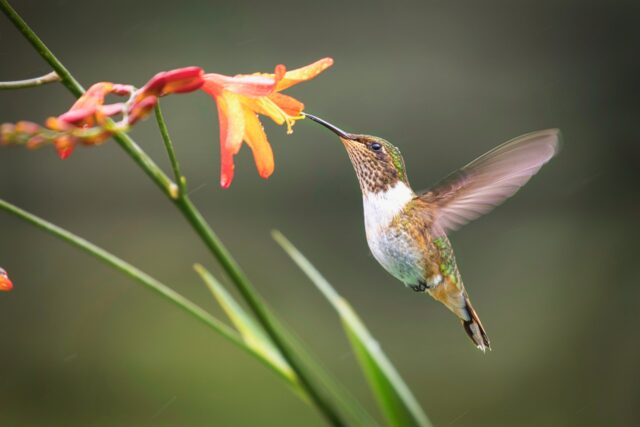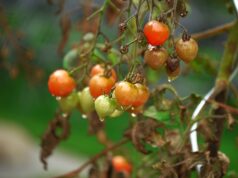Spotting a hummingbird in your garden is one of the delights of summer. From their brightly colored feathers to their swift movements, they are fascinating to watch. Even better, their speed and penchant for nectar make them one of nature’s most effective pollinators. Fortunately for gardeners and hummingbird-enthusiasts alike, by providing the proper environment, shelter and food sources, it can be incredibly easy to attract these fascinating little birds to your backyard.
Choosing the right plants for your hummingbird garden
The most important part of creating your own hummingbird habitat is to select the right flowers and planting arrangements that will most appeal to visiting hummingbirds. While there are many factors to consider, choosing the correct flower colors, shapes and bloom times can make your backyard particularly appealing to hummingbirds.
Select tubular, nectar-rich flowers hummingbirds love
When it comes to choosing which flowers to add to your hummingbird garden, it is helpful to consider the unique anatomy of hummingbirds. Their long, slender bill makes them perfectly adapted to feed from narrow, tubular flowers, such as trumpet vines. Additionally, although hummingbirds do not have a sense smell, they have highly developed eyesight and are particularly drawn to red flowers.
A good rule of thumb when selecting flowers for your garden is to opt for brightly colored varieties, with long tubular shapes and plenty of nectar.
Choose native plants
Like bees, butterflies and other pollinators, hummingbirds in your region are best adapted to feed from native plants. When given a choice between a native plant, such as columbine, and a non-native species, hummingbirds will frequently choose the native variety.
Not only are native pollinators more likely to be attracted to native plants but, because native plants grow naturally in your region, they are better adapted to the specific climate and weather patterns of your location, making them easier to grow and maintain.
Plant sequentially for continuous blooms
To ensure frequent hummingbirds visits to your garden, it is essential to provide a constant and reliable source of nectar. Though a favorite among hummingbirds, spring-blooming lupines are little use to hungry pollinators when their blooms die back in the heat of the summer. Planting sequentially blooming plants, such as lupines, zinnias and butterfly bushes, can guarantee a ready supply of nectar for hummingbirds throughout the growing season.
When selecting plants for a continuously blooming landscape, look for varieties with long-lasting blooms, like Agastache, and plants that bloom repeatedly throughout the season, such as petunias.
Taking your hummingbird garden design further
Planting flowers that hummingbirds love is rewarding for gardeners and hummingbirds alike. However, creating your own hummingbird garden does not have to end there. Below are a few additional tips and tricks to make your garden irresistible to visiting hummingbirds.
Add hummingbird feeders
Hummingbird feeders come in a wide range of striking shapes, designs and colors. Some feature a single nectar reservoir while some are designed to adhere to windows to allow you to observe hummingbirds feeding close up. Because hummingbirds are particularly drawn to the color red, most hummingbird feeders on the market are brightly colored with lots of red.
If you choose to add feeders to your garden, locate them in areas where they will be easy to spot and where hummingbirds will have enough space to hover around them when feeding. Because male hummingbirds are notoriously territorial, it is often best to have more than one feeder and to space feeders at least 15 feet apart. Feeders should be placed outdoors early in spring, several weeks before migrating hummingbirds are expected to arrive, and they should be left out until hummingbirds migrate away in fall.
To keep your pollinators happy and healthy, it is important to clean your feeders regularly, approximately every three to four days and more frequently in hot weather. To clean your feeders, wash them thoroughly in hot water with diluted vinegar; harsh chemicals, soaps and bleach should be avoided. If you notice your feeders are looking dull and drab, consider sprucing up the color with nail polish (allowing the polish to dry completely before placing the feeder outside) or replace your feeders with new ones so the colors remain alluring for hummingbirds.
Red dye in hummingbird food is not necessary and is potentially even toxic to hummingbirds. To create your own hummingbird nectar, simply mix one part refined white sugar with four parts water and stir thoroughly until the sugar dissolves completely. It is important that only refined white sugar be used. Once mixed, your homemade hummingbird nectar will last in the refrigerator for up to two weeks.
Use color throughout your garden
While hummingbirds can see a wide range of colors, they are particularly drawn to the colors red, orange, yellow and pink. Planting flowers in these colors and adding bright red feeders to your garden will help catch the attention of hungry hummingbirds. For more color, consider tying red and orange ribbons to trees and shrubs, include brightly colored garden decor or embellish your door wreath with some red silk flowers.
Hang up a protein feeder for nesting hummingbirds
Although hummingbirds primarily feed on nectar, they also eat small insects like mosquitos, beetles, aphids and spiders. Hummingbirds also hunt insects to feed their young. To encourage adult hummingbirds to nest in your yard, consider adding a protein feeder.
Hummingbird protein feeders are hanging feeders that are filled with ripe fruit. As the fruit begins to ferment, it attracts small insects, such as fruit flies, which are ideal food for hummingbird young. If you choose to use a protein feeder, be sure to clean it at least once a week.
Plant bushes and shrubs for hummingbird shelter
If you have the space for it, planting trees and shrubs throughout your garden will provide shelter and safety for traveling hummingbirds encouraging them to take up residence and even nest in your yard. Although any shrub or tree will do in a pinch, look for native trees and shrubs or flowering bushes like hibiscus, butterfly bush and lilacs, which are more likely to attract hummingbirds.
Create your own DIY snag perch
Snag perches are small perches, such as thin branches or twigs, that hummingbirds perch on while surveying their favorite feeding and nesting territories. Male hummingbirds, in particular, will take advantage of snag perches to guard their territory and keep a lookout for rival males.
You can make your own natural snag perch by placing a dead branch or twig vertically in the ground 10 to 50 feet away from hummingbird feeders or flower beds. Store-bought snag perches can also be purchased online.
Include a water feature
Like all animals, hummingbirds need fresh, clean water to thrive. Adding a bird bath to your garden is sure to lure hummingbirds and other feathered friends alike. Because hummingbirds are particularly fond of misting sprays, consider purchasing a solar powered water fountain for your bird bath or a mister attachment for your garden hose. Misting sprays will be irresistible to hummingbirds when temperatures rise during hot summer days.
Best flowers to include in your hummingbird garden
While hummingbirds will feed from a wide range of flowers, some plants are simply more appealing to hummingbirds and are more likely to draw visitors into your garden. Adding a number of different types of plants will increase the chance that hummingbirds will visit, so choose several different varieties. Some of the best plants to grow in your hummingbird garden include:
- Cardinal flower
- Catmint
- Salvia
- Trumpet vine
- Trumpet honeysuckle
- Flowering tobacco
- Butterfly bush
- Bleeding hearts
- Delphinium
- Lupine
- Petunia
- Coral bells
- Agastache
- Zinnia
- Beebalm
- Eastern red columbine
- Hosta
Conclusion
Hummingbirds, like other pollinators, are a delight in the garden. Their colorful feathers and intriguing flight patterns and displays are sure to thrill gardeners and visitors of all ages. When you understand the basic requirements hummingbirds need to thrive, beginning your own hummingbird garden can be as simple as planting a few flowering plants, hanging a feeder and sitting back to wait for these fascinating pollinators to arrive. Let creativity strike you and get planting your hummingbird garden today.








